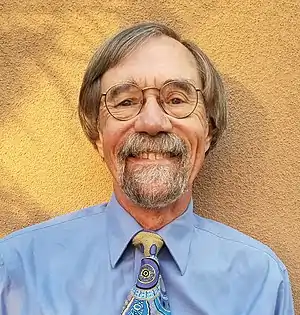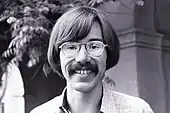Carlton M. Caves
Carlton Morris Caves is an American physicist. He is currently Professor Emeritus and Distinguished Professor in Physics and Astronomy at the University of New Mexico.[1] Caves works in the areas of physics of information; information,[2] entropy, and complexity; quantum information theory; quantum chaos, quantum optics; the theory of non-classical light; the theory of quantum noise; and the quantum theory of measurement.
Carl Caves | |
|---|---|
 Caves in October 2020 | |
| Born | 24 October 1950 (age 70) |
| Citizenship | United States |
| Alma mater | Rice University Caltech |
| Known for | Quantum information, quantum metrology |
| Awards | Einstein Prize (1990) Max Born Award (2011) |
| Scientific career | |
| Fields | Physics |
| Institutions | University of New Mexico Caltech University of Southern California |
| Doctoral advisor | Kip Thorne |
| Doctoral students | Samuel L. Braunstein Michael Nielsen |

Background and education
Caves was born in Muskogee, Oklahoma, on October 24, 1950, the son of Morris and Mary Caves. He attended public schools in Muskogee and graduated from Muskogee Central High School (now Muskogee High School) in 1968. One of his chief high-school activities was participation in MHS’s debate program; his debate partner, Mike Synar, served as Congressperson from the Muskogee district from 1979 to 1994. Caves attended Rice University as an undergraduate, receiving a BA in physics and mathematics in 1972, and then was a graduate student at the California Institute of Technology, where he received a PhD in physics in 1979. His PhD research, culminating in a dissertation entitled Theoretical Investigations of Experimental Gravitation, was carried out under the supervision of Kip S. Thorne. As a PhD student, Caves received the Richard P. Feynman Fellowship in 1976–77 and was the first recipient of the Öcsi Bácsi “Deeply Dedicated to Physics” Award in 1976.
Career
After receiving his PhD, Caves continued at Caltech as a Research Fellow in Physics (1979–81) and then as Senior Research Fellow in Theoretical Physics (1982–87). During 1987–92 he was Associate Professor of Electrical Engineering (and Physics from 1989) at the University of Southern California. He moved to Albuquerque in 1992 to become a Professor of Physics and Astronomy at the University of New Mexico (UNM). In 2006 he was promoted to Distinguished Professor, UNM’s highest faculty rank. In 2009 he was appointed the inaugural Director of the Center for Quantum Information and Control (CQuIC), an interdisciplinary center at UNM and the University of Arizona, which investigates and develops a new generation of technologies for controlling the behavior of quantum systems. Caves is best known for his proposal[3] in 1981 that squeezed light injected into the vacuum port of an interferometer can improve the interferometer’s sensitivity for detecting small phase changes. This proposal prompted thirty years of technology development to design squeezed-light sources that can improve the exquisite sensitivity achieved by the very large interferometers that have been constructed to detect gravitational waves from astrophysical events. The squeezed-light technique has been demonstrated in the GEO600, LIGO and Virgo gravitational-wave detectors.[4][5][6]
Caves has also made contributions to the theory of continuous measurements in quantum mechanics, participated in initial work on what is now called Quantum Bayesianism, worked on a proposal for doing two-qubit quantum gates on neutral atoms trapped in an optical lattice, helped to clarify the role of quantum entanglement in Nuclear Magnetic Resonance (NMR) simulations of quantum computation, and explored the role of nonclassical correlations outside of quantum entanglement as the resource that powers quantum computation.
The infamous quote "Hilbert space is a big place!" is attributed to Caves in a paper on quantum information.[7]
Caves is the author of over 140 scientific papers on these and other topics. His present research is concentrated on quantum metrology, quantum control, and quantum information science.
Caves has also made critical comments[2][8] on J. Richard Gott’s use of a temporal Copernican principle to predict the future duration of a phenomenon based only knowing the phenomenon’s present age.
Family and other interests
Caves married Karen L. Kahn on 3 June 1984. They reside in Albuquerque, where Kahn is a partner at the law firm of Modrall Sperling. They have two children: Jeremy Caves Rugenstein, a Humboldt Postdoctoral Fellow at the Department of The Land in the Earth System at Max Planck Institute for Meteorology, and Eleanor Caves, a Post-doctoral researcher in Biology at Duke University. In addition to his scientific interests, Caves is an avid bird-watcher and an ardent environmentalist. He was a member of the Board of Audubon New Mexico and Chair of the Board’s Conservation Committee.[9]
Awards and honors
- 1972–75 — National Science Foundation (NSF) Predoctoral Fellow
- 1976–77 — Richard P. Feynman Fellowship (as a PhD student)
- 1976 — inaugural recipient of the Öcsi Bácsi “Deeply Dedicated to Physics” Award
- 1990 — (with Daniel Walls) Einstein Prize for Laser Science from the Society for Optical and Quantum Electronics
- 2004 — elected a Fellow of the American Physical Society
- 2008 — elected a Fellow of the American Association for the Advancement of Science
- 2011 — Max Born Award from the Optical Society of America
- 2018 — Quantum Communication Award, International Conference on Quantum Communication, Measurement and Computing (QCMC) [10]
- 2020 — elected a member of the National Academy of Sciences [11]
See also
References
- "Carlton M. Caves". UNM Physics and Astronomy Faculty and Staff Directory. Archived from the original on 19 April 2012. Retrieved 25 March 2019.
- Glanz, James (8 February 2000). "ESSAY; Point, Counterpoint and the Duration of Everything". The New York Times. p. 5. Retrieved 21 July 2012.
- Caves, C. M. (1981). "Quantum-mechanical noise in an interferometer". Phys. Rev. D. 23 (8): 1693–1708. Bibcode:1981PhRvD..23.1693C. doi:10.1103/physrevd.23.1693.
- LIGO Scientific Collaboration (2013). "Enhanced sensitivity of the LIGO gravitational wave detector by using squeezed states of light". Nature Photonics. 7 (8): 613–619. arXiv:1310.0383. Bibcode:2013NaPho...7..613A. doi:10.1038/nphoton.2013.177.
- "Ligo Magazine". Sep 2013.
- Castelvecchi, Davide (2019-04-02). "Gravitational-wave hunt restarts — with a quantum boost". Nature. Retrieved 2019-04-22.
- Caves, Carlton M.; Fuchs, Christopher A. (1996). "Quantum information: How much information in a state vector?". arXiv:quant-ph/9601025.
- Caves, C. M. (2000). "Predicting future duration from present age: A critical assessment". Contemp. Phys. 41 (3): 143–153. arXiv:astro-ph/0001414. Bibcode:2000ConPh..41..143C. doi:10.1080/001075100181105. S2CID 16880494.
- Board of Directors, Audubon New Mexico
- "QCMC 2018 - Awards". Retrieved 2020-10-19.
- "2020 NAS Election". www.nasonline.org. Retrieved 2020-04-29.
External links
- Caves's homepage
- Caves's CV
- Center for Quantum Information and Control, UNM
- Caves's New Mexico Diaries
- Caves's father
- Caves's mother
- Caves's math genealogy
- Publications of Carlton Morris Caves in the database SPIRES
- arXiv.org preprints for C. Caves
- search on author Carlton Caves from Google Scholar and his Google Scholar profile